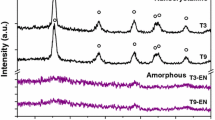Abstract
The nucleophilic substitution of fluorine of aromatic compounds with n-aminoalkyl trialkoxysilanes and consecutive sol-gel process have been used for the fabrication of various chromophoric sol-gel materials. The displacement of the fluoro substituent of an activated aromatic molecule occurs by a primary or secondary amino group of (CH3O)3Si-(CH2)3-NHR [R- = H-; CH3-, (CH3O)3Si-(CH2)3-] in tetraalkoxysilane or alcohol as solvent and the sol-gel process can be carried in the same vessel. The HF formed is trapped by a tertiary amine and simultaneously serves as the catalyst for the sol-gel process. Various aromatic compounds have been checked for this purpose: 1-(4-fluorophenyl)-2-nitroethylene, 1-(4-fluorophenyl)-2,2-dicyanoethylene, 4-fluorobenzonitrile, 4-fluoronitrobenzene, 4,4′-difluorobenzophenone, 4,4′-difluorobenzil, 7,7′-difluorodibenzylideneacetone, tetrafluoro-p-benzoquinone, and 1,5-difluoro-2,4-dinitrobenzene. Mono and disubstitution has been studied by UV/Vis- and solid state NMR spectroscopy of the xerogels.
Similar content being viewed by others
References
C.J. Brinker and G.W. Scherer, Sol-Gel Science (Academic Press, New York, 1989).
C.K. Jorgensen and R. Reisfeld, Optical and Electronic Phenomena in Sol.-Gel. Glasses and Modern Application (Springer, Berlin, 1996).
R. Gvishi, U. Narang, G. Ruland, D. Kumar, and P. Prasad, Appl. Organomet. Chem. 11, 107 (1997).
D. Avnir, L.C. Klein, D. Levy, U. Schubert, and A.B. Wojeik, in The Chemistry of Organosilicon Compounds–Part 2, edited by Y. Apeloig and Z. Rapporport (Wiley & Sons, Chichester, 1997), Ch. 48.
B. Lebean, J.Z. Brasselet, and Z.C. Sanchez, Chem. Mater. 9, 1017 (1997).
F. Del Monte and D. Levy, J. Sol.-Gel Sci. Technol. 8, 585 (1997).
Ll. Hu and Z.H. Jiang, SPIE Sol.-Gel. Opt. IV 3136, 94 (1997).
E.J.A. Pope, SPIE Sol.-Gel. Opt. III 2288, 410 (1994).
M.D. Rahn, T.A. King, C.A. Capozzi, and A.B. Seddon, SPIE Sol.-Gel. Opt. III 2288, 410 (1994).
C. Sanchez and F. Ribot, New J. Chem. 18, 1007 (1994).
J.D. MacKenzie, Sol.-Gel Optics III, Proc. SPIE 1994, p. 2288.
M. Anva, A. Dubots, P. Georges, A. Brun, F. Chaput, and A. Ranger, in Proc. SPTF-Int. Soc. Opt. Eng. (Sol.-Gel Optics III) 2238, 298 (1994).
S.C. Klein, Sol.-Gel Optics, Processing and Applications, (Kluwer Academic Press, Boston, 1994).
S. Pandey, G.A. Baker, M.A. Kane, N.J. Bonzagni, and F.V. Bright, Chem. Mater. 12, 3547 (2000).
J. Sauer and R. Huisgen, Angew. Chem. 72, 294 (1960).
E. Buncel, M.R. Crampton, M.J. Strass, and F. Terier, Electron Deficient Aromatic Heteroaramatic–Base Interaction (Elsevier, Amsterdam, 1984).
M.R. Campton, in Organic Reaction Mechanism 1996, edited by A.C. Knipe and W.E. Watts (John Wiley & Sons, 1999), p. 147, 162.
A.J. Belfield, G.R. Brown, and A.J. Foubister, Tetrahedron 55, 11399 (1999).
K. Neimann and R. Neumann, Chem. Commun. 487 (2001).
A.G.S. Prado and C. Airoldi, J. Coll. Interf. Sci. 236, 161 (2001).
B. Boury and R.J.P. Corriu, Adv. Mat. 12, 989 (2000).
R.J.P. Corriu, Angew. Chem 112, 1433 (2000).
S. Spange, A. Seifert, H. Müller, S. Hesse, and C. Jäger, Angew. Chem. 114, 1805 (2002).
N. Marcotte and S. Fery-Forgues, J. Chem. Soc., Perkin. Trans. 2, 1711 (2000).
H. Annoura, K. Nakanishi, T. Toba, N. Takemoto, S. Imajo, A. Miyajima, Y. Tamura-Horikawa, and S. Tamura, J. Med. Chem. 43, 3372 (2000).
C. Reichardt, Chem. Rev. 94, 2319 (1994).
S. Spange, A. Reuter, and D. Lubda, Langmuir 15, 2103 (1999).
S. Spange, Y. Zimmermann, and A. Gräser, Chem. Mat. 11, 3245 (1999).
S. Spange and D. Keutel, Liebigs Ann. Chem. 423 (1992).
Rights and permissions
About this article
Cite this article
Seifert, A., Spange, S., Müller, H. et al. Fabrication of Chromophoric Xerogels by Synergistic Combination of Nucleophilic Aromatic Substitution and the Sol-Gel Process. Journal of Sol-Gel Science and Technology 26, 77–81 (2003). https://doi.org/10.1023/A:1020789318803
Issue Date:
DOI: https://doi.org/10.1023/A:1020789318803




